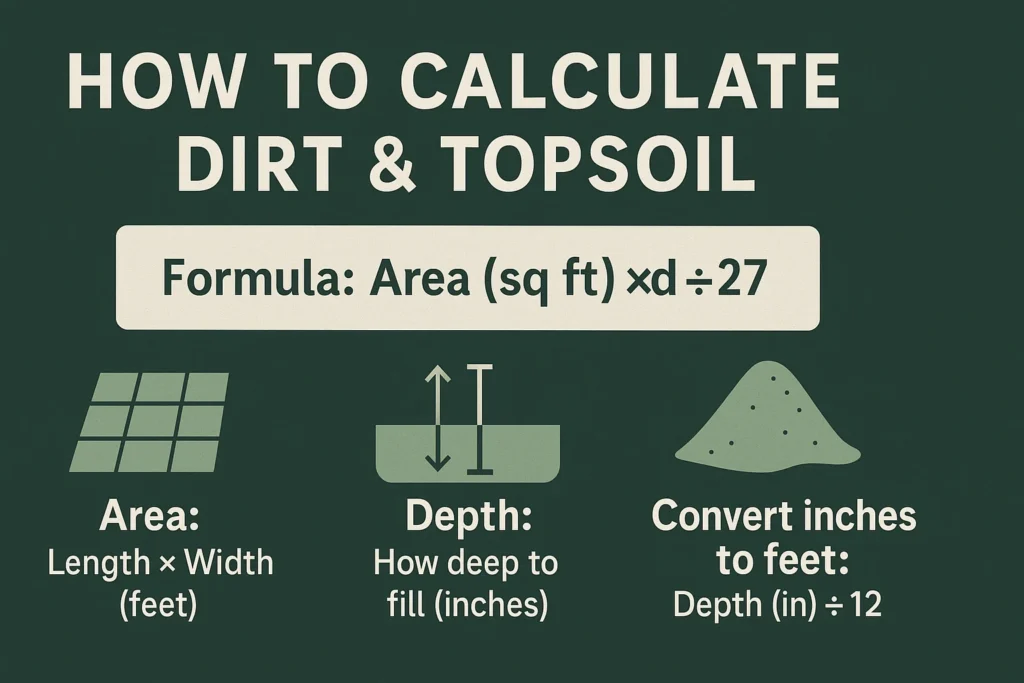Dirt & Topsoil Calculator
Dirt & Topsoil Calculator

Created by James S. Lockwood
With a background in botany and ecological sciences, James specializes in creating practical tools and resources to help gardeners, farmers, and plant enthusiasts optimize their green spaces.
Our Topsoil Calculator and Dirt Calculator help you accurately determine the amount of soil, fill dirt, or topsoil required for your project. Whether you need to level a lawn, create a raised garden bed, or fill holes, our Soil Volume Calculator provides precise cubic yard estimates to ensure you purchase the right amount of material.
Table of Contents
What Is Topsoil?
Topsoil is the uppermost layer of soil, typically the top 2 to 8 inches. It contains a mix of organic matter, minerals, air, and microorganisms essential for plant growth. This layer is where most biological soil activity happens and where plants establish their root systems. High-quality topsoil is loose, nutrient-rich, and well-draining, making it ideal for gardening, landscaping, and lawn preparation.
What Is Dirt in Soil?
Dirt is essentially soil that has been removed from its natural ecosystem, losing its structure, nutrients, and living components in the process. In technical terms, dirt isn’t a scientific classification—it’s just soil that’s out of place. While it can be used for grading or filling, it usually needs to be improved with organic matter if you plan to grow anything in it.
What Is the Difference Between Topsoil and Dirt?
Topsoil is structured, nutrient-rich, and biologically active—perfect for growing plants. Dirt, on the other hand, is displaced or degraded soil that lacks structure and fertility. Dirt may come from excavation, construction, or erosion and typically doesn’t contain enough organic matter or microbial life to support healthy plant growth unless it’s amended. In short, topsoil feeds plants—dirt fills space.
What Are the Three Types of Dirt?
There are three main types of soil-based “dirt,” classified by their particle size and composition:
Sand – Large particles, drains quickly, low in nutrients
Silt – Medium particles, smooth texture, holds moisture well
Clay – Small particles, holds water tightly, often compacted
The best growing soils are often a loam, which is a balanced mix of sand, silt, and clay.
What Is the Difference Between Compost, Dirt, and Soil?
Compost is decomposed organic matter used to enrich soil. It’s biologically active and full of nutrients but not a growing medium by itself.
Soil is a complete ecosystem made of minerals, organic matter, air, water, and microbes. It supports plant life.
Dirt is soil that has lost its structure or life—typically removed from its original context and low in nutrients.
To grow healthy plants, you often need a mix: soil for structure, compost for nutrients, and sometimes dirt for volume or grading.
Why Use Our Topsoil & Dirt Calculator?
- Accurate Volume Estimates – Get cubic yards and cubic feet calculations instantly.
- Adjustable Depth & Coverage – Calculate based on your desired soil depth.
- Multiple Material Types – Choose from topsoil, fill dirt, or garden soil.
- Project-Specific Adjustments – Customize results based on your landscaping or construction needs.
- Weight & Cost Estimation – Convert soil volume to weight and estimate costs per cubic yard.
How Much Topsoil Do I Need?

The amount of topsoil you need depends on the size of your area and the depth you want to cover. For most gardening and lawn projects, a depth of 2 to 6 inches is common. Lighter applications like lawn touch-ups may only need 2 inches, while new garden beds or full lawn installations often require 4 to 6 inches.
To calculate the volume of topsoil, use this formula:
Topsoil Volume Formula (Cubic Yards):
Area (sq ft) × Depth (inches) ÷ 324 = Cubic Yards
Area = length × width of the space in feet
Depth = how thick you want the topsoil layer (in inches)
324 = conversion factor to get cubic yards from square feet and inches
Example:
You’re covering a 1,000 sq ft lawn with 4 inches of topsoil:
(1,000 × 4) ÷ 324 = 12.35 cubic yards
Our Topsoil Calculator does the math for you—just enter your dimensions and preferred depth, and it will give you an instant estimate in cubic yards, cubic feet, and bag quantities if you’re buying retail. It even factors in delivery costs if needed, so you get an accurate plan before you order.
How to Calculate Yards of Dirt?
To calculate how many cubic yards of dirt you need, you’ll need three basic measurements: length, width, and depth of the area you’re filling. These measurements should be in feet, and depth can be converted from inches if needed.
Cubic Yards Formula:
Length (ft) × Width (ft) × Depth (ft) ÷ 27 = Cubic Yards
27 is the number of cubic feet in one cubic yard
If your depth is in inches, convert it to feet first by dividing by 12
Example:
You’re filling a space that’s 20 feet long, 10 feet wide, and 6 inches deep.
Convert 6 inches to feet:
6 ÷ 12 = 0.5 feetPlug into the formula:
20 × 10 × 0.5 ÷ 27 = 3.7 cubic yards
So, you’d need about 3.7 cubic yards of dirt for that project.
Our Dirt Calculator uses this formula to give you instant results. Just input your area and depth, and it tells you exactly how much dirt to order—no guesswork, no overbuying.
How much does Cubic Yard of Topsoil Weigh?
A cubic yard of topsoil typically weighs between 1,800 and 2,700 pounds, depending on its moisture content and composition.
Dry, loose topsoil: around 1,800–2,000 lbs per yard
Moist, compacted topsoil: up to 2,500–2,700 lbs per yard
If you’re dealing with freshly delivered bulk topsoil that’s been sitting in the rain, expect it to be on the heavier end of that range.
💡 Quick Reference:
1 cubic yard = 27 cubic feet
A full pickup truck bed usually holds about 1–2 cubic yards, depending on size and weight capacity
When ordering, always check with your supplier for the exact weight if you’re hauling it yourself, to avoid overloading your vehicle.
How Many Yards of Dirt Do I Need?
To figure out how many yards of dirt you need, you’ll need the area size (in square feet) and the depth of dirt you want to apply (in inches). Then, use a simple formula to convert that volume into cubic yards, which is how dirt is typically sold in bulk.
Cubic Yards Formula:
Area (sq ft) × Depth (inches) ÷ 324 = Cubic Yards
Example:
If you’re filling a 500 sq ft area with 4 inches of dirt:
500 × 4 ÷ 324 = 6.17 cubic yards
So, you’d need about 6.2 cubic yards of dirt for your project.
To make things easier, use our Dirt Calculator—just enter your area and depth, and it gives you instant results in cubic yards, cubic feet, and even bag count.
Bagged vs. Bulk Dirt Comparison
When choosing between bagged and bulk dirt, it comes down to project size, convenience, and cost. Bagged dirt is easy to handle, store, and transport, making it ideal for small garden projects or touch-ups. However, it’s significantly more expensive per cubic yard and creates more packaging waste. Bulk dirt is much more cost-effective for larger areas like lawn installations or grading work, and it’s delivered directly to your site. While bulk requires more effort to move and spread, it offers better value and efficiency for medium to large-scale jobs.
How Many Bags of Dirt in a Cubic Yard?
One cubic yard equals 27 cubic feet, so the number of dirt bags you’ll need depends on the bag size you’re buying.
If you’re using 1 cubic foot bags, you’ll need 27 bags to make up a cubic yard.
For 0.75 cubic foot bags, you’ll need 36 bags (27 ÷ 0.75 = 36).
For 2 cubic foot bags, you’ll need about 13.5 bags—round up to 14 for full coverage.
Buying in bulk is usually cheaper if you need more than a yard, but bagged dirt can be more convenient for smaller jobs or hard-to-reach areas. Our Dirt Calculator can help you determine how many bags you need based on your project size and bag size.
Other Helpful Calculators for Your Garden Project
Once you know how much compost you need, you may want to calculate other materials commonly used alongside it. These tools can help you plan your full setup with precision:
Mulch Calculator
Planning to mulch over your compost layer? This tool estimates how much mulch to buy for proper coverage, moisture retention, and weed control.Garden Bed Planner
Building or planting raised beds? This tool helps you lay out dimensions, spacing, and materials—including compost, soil, and space between plants.
Frequently Asked Questions (FAQs)
How do you calculate how much dirt you need?
To calculate how much dirt you need, multiply the area (length × width) in feet, convert the depth from inches to feet (divide by 12), then divide the total volume by 27 to get cubic yards.
Formula: Length × Width × Depth ÷ 27 = Cubic Yards
How much ground does 1 ton of dirt cover?
One ton of dirt typically covers 20 to 24 square feet at a depth of 6 inches, depending on the type of soil and moisture content.
What is dirt measured in?
Dirt is usually measured in cubic yards for bulk orders, and in cubic feet or pounds when purchased in bags.
How much will 1 yard of dirt cover?
One cubic yard of dirt covers approximately 100 square feet at 3 inches deep or 324 square feet at 1 inch deep.
How much dirt is 5 yards?
Five cubic yards of dirt equals 135 cubic feet and will cover around 500 square feet at 3 inches deep.
How to calculate soil volume?
To calculate soil volume in cubic yards, use this formula:Area (sq ft) × Depth (inches) ÷ 324 = Cubic Yards
How do you measure soil formula?
To measure soil volume, calculate the area and depth as described above. To measure soil composition, use a soil test to determine the percentage of sand, silt, and clay.
How do you calculate yard size?
Measure the length and width of your space in feet and multiply them to get the square footage. Use this number to calculate how much material (like dirt or soil) you need based on depth.
How much is 1 cubic yard of dirt?
One cubic yard of dirt weighs around 2,000 to 2,700 pounds, depending on moisture content. The cost ranges from $30 to $60 per yard for bulk delivery in most areas.
Disclaimer for Dirt & Topsoil Calculator
The Dirt & Topsoil Calculator provides estimates only. Actual dirt requirements may vary based on soil compaction, moisture content, and application method. Always consult with a professional supplier before ordering. We are not responsible for any discrepancies between estimated and actual material needs.
Discover Crop & Farming Calculators
